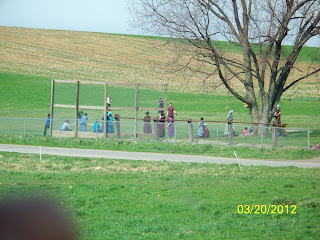My husband and I took a trip to Holmes County, Ohio last year, which happens to hold the largest concentration of Amish in the United States. It was a beautiful trip, though still crisp with the last dregs of cold weather. We saw the Amish everywhere, of course; on the roads, on their farms, the children playing in their school yards. We also noticed that a good many of them own businesses, so they are in the stores and eateries, too.
When you visit Holmes County, you can learn about the Amish in two ways: First, through the tourist exhibits and local museums; and secondly, by seeing and interacting with present-day Amish. I put up a few more photos from our trip on my website here (scroll down the page),
but to see all of our photos, you'll need to be on my newsletter mailing list. (Sign up at http://www.LinoreBurkard.com)
The museums were wonderful, especially the Amish and Mennonite Heritage Center, which boasts a 360 degree wall mural that depicts the history of the "plain people" from their European roots to their trek to America and henceforward. There's a tour guide who talks you through the exhibit with lots of anecdotes and interesting facts. There's also tours of working farms, as well as Amish homes and a schoolroom, no longer being used, but good examples of how things were--and ARE.
(Which is key for most Amish. The way things were is the way things are. If you ask why they do things the way they do, you will likely hear, "Because that's the way we've always done them.")
 | ||
| Amish School Room (Part of the tour) |
I used to think that the lifestyle choices of the Amish which have to do with rejecting modern technology (like cars and electricity) were based on religious principles. Simplicity, perhaps. Or limiting distractions and temptations, maybe? But, no! Their lives are based primarily on TRADITION.
This is not to say that there are no religious people among the Amish, for there are. But if you study how they run their "churches" (not really a church, but an "order," which really just denotes their local community, as opposed to a local community based elsewhere, geographically) even this is based upon tradition.
The preacher is drawn by lot in some cases, for instance, which certainly precludes individual preference and doesn't mean that those who do not feel either called or gifted in this area will not BE called upon to lead church services. Likewise, they do not follow a systematic theology, which leaves them open to all kinds of error and lack of information. I am not writing this to critique the Amish or their lifestyle, but I couldn't help noticing the pitfalls inherent to such a system, if you can call it a system. They do not use a church building, as their services are held in homes, each household taking a turn to host the huge gathering. (Which is no small task. There is much involved in hosting, from seating arrangements--often in the barn--to food, parking for carriages, etc.)
We could easily tell which home was holding the gathering, as Amish on foot, in carriages, and by horse were all leading inexorably to that one homestead, like little shavings drawn to a magnet. It was quite picturesque, as well as fun to hear the steady clop-clop-clop of the horses. We also discovered that they do not keep necessarily early hours, as we heard their distinctive sound far into the evening, well past nine or ten o'clock.
Every Amish order has their own rules and differ in what they allow regarding modern technology. We saw a young man with a bicycle that had no pedals. (I forget why they weren't allowed.)
There is really a wealth of information to be learned regarding the Amish, and I wish I'd posted shortly after my visit when I could remember more of the little facts that were so interesting.
In any case, enjoy the pictures!
 | ||
| Most Amish do not display a great deal of artwork, but Scripture verses, samplers, and even quilts are among the exceptions. The above states, "Thou art my Hope." |
I'll be putting a great deal more photos from my trip into my next newsletter edition, so if you'd like to receive that, please be sure you're subscribed to the mailing list! (Subscribe HERE. It's free.)
An interesting book I have on my "to read" list, is: (Click the book cover to see it on Amazon for more info)
 | ||||||
| AMISH PRAYERS |
What about you? Do you read Amish fiction? Are you curious about their lifestyle, too? Got a favorite read to recommend? Let us know! Leave a comment and you'll be entered in a drawing for a three-tin set of "ENGLAND'S FAVOURITE TEAS."
The three teas are: English Breakfast Tea, English Afternoon Tea and London Tea. They are loose tea leaves, which will steep into a lovely, flavorful pot or cup. (If you don't have an actual tea-leaf strainer, any fine strainer will do.) What is an actual tea strainer? See this, for example:
Progressive Stainless Steel Mesh Tea Ball
Such as, Brew-in-Mug Extra-Fine Tea Infuser with Lid
I need a minimum of twelve comments from unique visitors (multiple comments from one person will only count as one comment) to hold the drawing, so please tell your friends!
Warmest Blessings,
Linore









